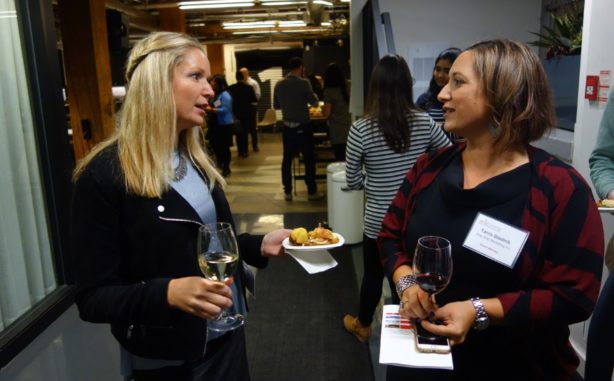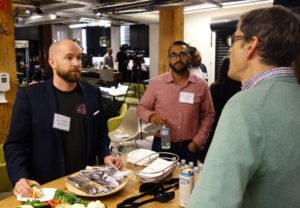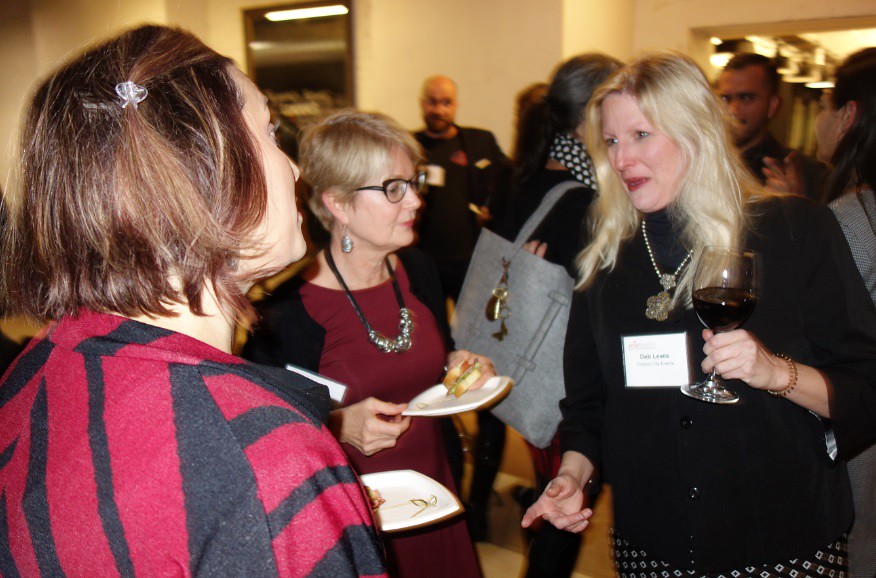Part of the Connect, Learn, Grow series of networking events hosted by AMA Toronto Chapter, the November 15th 2016 panel discussion entitled The Future Today: How Marketers Can Leverage Emerging Technologies was a terrific example of the excellent work this organization does to keep the city’s tech community at the leading edge of global innovation. Organized by Tania Stadnik B2B marketing consultant and current AMA Toronto President, the charismatic lady welcomed guests to the intriguing venue with a handshake and a friendly smile.
 Situated in lobby meeting space of Jackman Reinvents at 345 Adelaide St W, the AMA Toronto executives mingled with technologists, authors, teachers and of course marketing mavens from some of the biggest ad agencies in the city. The tables were lined with fresh cut fruits & vegetables and delicious baked pastries and finger sandwiches of every description. Two types of beer were available and red and white wine flowed freely for guests. Joe Jackman himself led the speakers, introducing himself and the space and the idea of ‘necessary change’. He was speaking to the conservative thinkers and the limiters in every organization when he cautioned, ‘not making a decision is also a decision’.
Situated in lobby meeting space of Jackman Reinvents at 345 Adelaide St W, the AMA Toronto executives mingled with technologists, authors, teachers and of course marketing mavens from some of the biggest ad agencies in the city. The tables were lined with fresh cut fruits & vegetables and delicious baked pastries and finger sandwiches of every description. Two types of beer were available and red and white wine flowed freely for guests. Joe Jackman himself led the speakers, introducing himself and the space and the idea of ‘necessary change’. He was speaking to the conservative thinkers and the limiters in every organization when he cautioned, ‘not making a decision is also a decision’.

Rather than dive deep right into the new technologies, although there was some of some tech talk, three local thought leaders, Adam Green from Google, Kevin Keane from Brainsights, and Zahra Rajani the VP Digital Experience at Jackman Reinvents discussed processes and mind shifts that are key to implementing change in an organization.
The moderator Mark Vecchiarelli of Vekya Inc did a great job of keeping the discussion to three distinct areas of focus and he nicely summarized the best and most notable ideas and insights at the end of the session.
Chasing Shiny Things – The panel explored the idea of how and why marketing executives select ‘shiny new things’ to add to their arsenal of influence tools. Each speaker related ideas and anecdotes of past marketing campaigns where brands were rewarded for going first even if they didn’t necessarily turn out the best product.
 Adam Green from Google illustrated the point best by describing how Bud Light Beer made gains by being the first U.S. company to utilize Google’s TrueView 360 Video Ads. But then as a warning, Adam also scolded the copycat brands that have recently made similar spots that didn’t push the envelope of experience or, as the moderator Mark Vecchiarelli summarized later, ‘use the new technology to add value to the brand experience’.
Adam Green from Google illustrated the point best by describing how Bud Light Beer made gains by being the first U.S. company to utilize Google’s TrueView 360 Video Ads. But then as a warning, Adam also scolded the copycat brands that have recently made similar spots that didn’t push the envelope of experience or, as the moderator Mark Vecchiarelli summarized later, ‘use the new technology to add value to the brand experience’.
Connective Tissue – Mark focused the panel on the big question of how to implement necessary and effective change across the big organization? This was the issue Mr. Jackman alluded to in his introduction to the talk. Administrators that put off deciding on how to change their business practices are in fact making a decision that will have consequences. Adam presented the idea of a change scale where a car company would be at the slow end, and a software company at the fast end. He explained how the automotive sector is slow to change as it takes three years from blueprints to dealership for new cars to appear on the market, while a software company can update their website over the weekend and thus bring new products and services to market at lightning speed.
Zahra Rajani the VP Digital Experience at Jackman Reinvents chimed in here to offer up the idea that the process can be expedited by the stakeholders finding shared goals. She went on to explain how organizations are often a loose assembly of ‘siloed’ departments which happens naturally when team leaders streamline their own group’s efficiency. Adding ‘horizontal connective tissue’ can be extremely disruptive, but in the chaos new order is born. The panels shared more insights here adding that change-makers from each team or siloed section of the firm must work together to remove obstacles and finally these individuals should be the first to adopt and truly be the change they advocate.
 Asking the Right Questions – Kevin Keane from Brainsights shone in this third chapter of the discussion wherein the group detailed some ideas around the perception of change. Asking the right questions inside the organization and to outside consumers is key to success. Hillary Clinton lost the 2016 US Election because she misread and was mistrusted by the American people. Kevin Keane, whose agency reported on the brainwaves of Trump supporters at least once during that campaign explained how the Republican nominee’s messages were well targeted to stir excitement on important issues as per his test voter subjects’ recorded ECG brainwaves.
Asking the Right Questions – Kevin Keane from Brainsights shone in this third chapter of the discussion wherein the group detailed some ideas around the perception of change. Asking the right questions inside the organization and to outside consumers is key to success. Hillary Clinton lost the 2016 US Election because she misread and was mistrusted by the American people. Kevin Keane, whose agency reported on the brainwaves of Trump supporters at least once during that campaign explained how the Republican nominee’s messages were well targeted to stir excitement on important issues as per his test voter subjects’ recorded ECG brainwaves.
At one point Adam Green shared the 70, 20, 10 marketing budget concept, which the entire panel then digested after prompting by Mark. Apparently, Coca-Cola executives had, years ago, stated the company’s marketing budget ratio as seventy percent standard (a respectable mix of print and digital marketing) mixed with twenty percent emerging but relatively established marketing platforms, capped with ten percent experimental advertising. So here ‘asking the right questions’ is what marketing managers must do AFTER such a spend; the administrators must do a postmortem analysis on the success or failure of their marketing campaigns. In this scenario, with millions of dollars being spent on experimental advertising platforms, something is bound to go wrong and indeed if managers come back with a perfect score then they have in fact failed the company as they have no learning to report.

At the end of the session, Tania Stadnik reappeared to thank the moderators, speakers and guests. There was some applause and in that chorus the audience was thanking Tania and her team for organizing the forty-five minute feast of ideas on how to leverage future technology for marketing.
